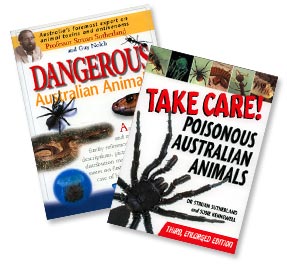![]()

The content within this section is available as a high
quality laminated, full-colour poster (approx. 650mm by 460mm), and includes
a valuable section on First Aid. The cost is $10 + postage.
Please use our contact form to order
your copy, or to obtain extra copies for your school.
ALSO available: AUSTRALIAN FRESHWATER TURTLES poster (approx. 450mm by 700mm)
Also available:
Dangerous Australian Animals
(Prof. Struan Sutherland & Guy Nolch)
Take Care! Poisonous Australian Animals
(Prof. Struan Sutherland & Susie Kennewell)
more details ...
Dangerous Creatures of Australia
Australia is home to the world’s most venomous
creatures. They are to be found in bushland, metropolitan parks and
beaches, even our
own backyards. All Australians should have knowledge of our venomous
wildlife and an understanding of correct first-aid procedures. Prevention
is always better than cure as nobody wants to have a holiday ruined by
a bite or sting.
Venomous creatures use their venoms and stinging apparatus to immobilise
food items and the venom is an aid in digesting such food items. Humans
are usually accidental victims.
The creatures depicted here shall never rival the Koala or Red Kangaroo
as popular symbols of Australia, yet they are a most important aspect
of our wild life heritage.
Snakes
Snakes evoke a reaction in people and have been present
throughout the history of man. Though they are generally shy, some
possess highly toxic
venoms, and Australia is home to the world’s most venomous (please
see list of venomous snakes).
Parents should not encourage children to keep snakes, however interest
in all aspects of environmental matters should be encouraged. Snakes
cannot hear, they have no eyelids, no legs. All snakes are excellent
swimmers and have a complex skeleton. Snakes are highly muscular.
The sense of smell is highly developed in snakes. The forked tongue of
a snake picks up minute particles and is its main organ in locating food.
The tongue is quite harmless. Snakes are opportunistic feeders and may
go for lengthy periods without food. Snakes are of great economic importance
as they are the main predators of rats and mice. Leave snakes alone!
The following pages will give you a better idea of some of our
most interesting Deadly Australians:World's Most Venomous Snakes
Dangerous Snakes of Australia
The Taipan
The Small-scaled Snake or Western Taipan
Common Brown Snake
Tiger Snake
Death Adder
Mulga Snake or King Brown Snake
Rough-scaled Snake
Sea-snake
Copperhead Snake
Red-back Spider
Funnel-web Spider
Australian Paralysis Tick
The Box Jellyfish
Blue-ringed Octopus
Puffer Toadfish
Stonefish
Blue Bottle or Portuguese Man-o-War
ConeshellAcknowledgement:- This humble work would not have been possible but for the enthusiastic support of the late Dr Struan Sutherland, Head of Immunology C.S.L. . His dedication, research and writings on venomous creatures and the care of the envenomated patient continues to inspire me. For excellent photos, I am indebted to the late Dr Sutherland, John Cann O.A.M., Keith Gillett, Gunther Schmida, Steven Swanson. I owe a special thanks to Liz of Royal Melbourne Hospital I.C.U. and the staff of I.C.U. R.M.H. who cared for me following a serious bite from a Tiger Snake in January 1988.
Dedication:- To all the children, parents and teachers of schools throughout Australia who have supported the Deadly Australians Programme
Bibliography:- Reptiles & Amphibians of Australia - Harold Cogger, Family Guide to Dangerous Animals and Plants - the late Dr S. Sutherland, Monograph of Snake Bite - R.F.D.S.
see our page on First Aid ...
